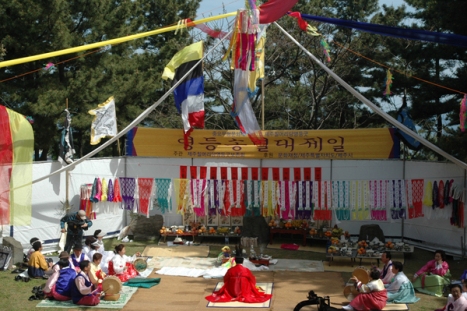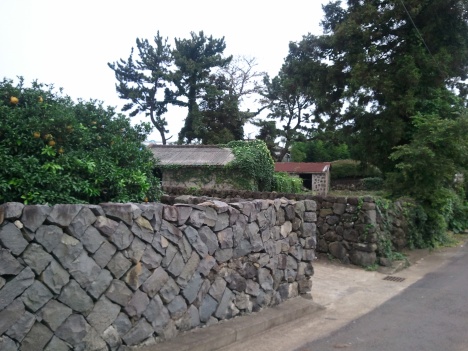[My article, reprinted from Yonhap News Agency]
The first place in the world to receive UNESCO designations in all three natural science categories, Jeju has its cultural foundation in the animistic belief among its people that the island is home to 18,000 gods.
Tamnaguk Ipchun Gutnori is a large shamanic ritual to welcome the coming of spring, and it entreats the gods’ blessing for a bountiful growing season and community prosperity.
“It’s a riotous display,” festival organizer Hong Sunyoung said.
When the gods have been sufficiently invoked, shamans, “cow,” and audience together parade 1 kilometer to a square where the remainder of the festival takes place. There, shamans further encourage the gods’ beneficence by performing a six-act mask dance while reciting the story of a farmer and his wish for another bountiful season.
Jeju has more than 400 shamanic shrines, or “dang” in the local dialect.
“I believe one village equals one dang,” says Moon Moo-byung, chief scholar of Jeju Traditional Culture Institute. “Villages naturally form where there is a god.”
“There is a very close relationship between our tradition of shamanism and the strong character of our women,” adds Moon Soon-deok, lead researcher of Jeju Development Institute.
Scholars believe that Jeju’s harsh natural conditions contributed to its cultural uniqueness. The island was formed by volcanic eruption and as such has an extremely rocky soil, long the bane of this agrarian society.
Its particularly windy climate has always represented a challenge not only to farmers but also those making their living from the sea, both fishermen and the famed diving women, or “haenyeo.” Frequent typhoons and other storms have contributed to the loss of many seafaring men, resulting in a gender imbalance.
“Jeju people can be melancholic,” mused renowned Jeju-born artist Byun Shi-ji, whose work hangs in the Smithsonian, “but diligently face challenges.”
At the foundation of Jeju culture is its mythology. Unlike mainland Korea and many world cultures with male-oriented creation myths, Jeju’s creation story centers on a giant goddess, Seolmundae Halmang. Its central volcano, sacred Mount Halla, is her embodiment.
The island’s oral tradition has a high proportion of goddesses and other powerful female imagery contributing to the character strength of Jeju women, written about in detail by mythologists Kim Soonie and Koh Heakyoung, among others.
“Jeju is not ‘matriarchal’ as often misreported,” Koh said. “Women have not held many positions of leadership. Instead, it’s ‘matrifocal.’ There has always been a strong emphasis on its women, which in turn has given them strength of character.”
Jeju’s communal fishing customs can be seen in the haenyeo, women who dive in order to harvest sea creatures and products. The diving women in particular are found nowhere else in the world with the exception of the “ama” in southern Japan.
The vision of the island, officially called Jeju Special Self-Governing Province, is to become an international and ultra-modern city akin to Hong Kong or Singapore. Toward this goal, the island is pushing six major development projects, including the Global English Education City and Healthcare Town.
Of late, however, the development model is moving toward ‘glocalization’ — globalizing while at the same time preserving elements of Jeju’s unique local culture.
Filed under: Articles written by Dr Hilty [published], Culture(s), East Asian Philosophy, Environment / Ecology, Jeju Island, Shamanism / Animism, Women’s Issues
![]()

Dr. Anne Hilty is a Cultural Health Psychologist with a focus on the interplay of Eastern and Western theories of mental health as well as the mind-body connection. Her grounding is in the fields of cultural, transpersonal, and health psychology; she is additionally influenced by classical Chinese medicine, somatic psychology, and Asian shamanic traditions. Originally from the city of New York, Dr. Hilty lives on bucolic Jeju Island in South Korea, having previously lived in Seoul and Hong Kong.

 “Yeongdeung-gut,” one of shamanistic rituals of Jeju Island
“Yeongdeung-gut,” one of shamanistic rituals of Jeju Island  A common Jeju village home (Courtesy of Anne Hilty)
A common Jeju village home (Courtesy of Anne Hilty) “Haenyeo,” or diving women, an important part of Jeju’s unique culture.
“Haenyeo,” or diving women, an important part of Jeju’s unique culture.






